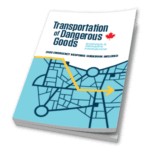Transport Canada Completes Study on e-Documents – What Next?
Let’s face it – many parts of the current systems in Canadian and US transportation regulations are not exactly in sync with modern technology. These systems trace back to methods from the early twentieth century (or even earlier), when the most modern tools for creating shipping papers were typewriters or that newest miracle of advanced technology, the ball-point pen. So, it’s been the standard that dangerous goods shipments in the US and Canada always have to be accompanied by a paper document including the essential information for emergency responders.
Now, nearly a hundred years later, we must ask if there’s a better way.
The Sandbox Study on Electronic Shipping Documents
Transport Canada has started to try to find an answer to that question. In early 2020, they started a “sandbox” study to see if electronic dangerous goods shipping documents would be feasible. The study concluded this spring, and a report of the findings has just been issued as of October 21.
First, you might ask, what is a “sandbox” study? Well, if you are familiar with video games, it’s a term meaning an activity where participants are allowed to do things without guidance and as they choose. Think of kids playing in a sandbox, happily digging, or constructing things without being told how to do it. This sort of study allows participants to come up with solutions that might not be obvious at first to regulators.
Of course, there’s a much bigger risk when dealing with real-life shipments of dangerous goods, so it wasn’t quite as free as your neighborhood playground. According to the report “Transport Canada identified companies interested in trialing e-shipping documents and worked one-on-one with them to come up with safe solutions using their existing operating systems.” In addition, special focus was given to firefighting groups in the area, and Transport Canada worked closely with the Canadian Association of Fire Chiefs to ensure responders were adequately protected. However, eventually volunteer companies were collected and provided with permits (equivalency certificates) to try out new methods of documenting dangerous goods shipments.
Some readers may have already realized a potential glitch – the start date was just before the COVID-19 pandemic hit. Although this didn’t stop the study, it did reduce the number and extent of exercises that could be done to test the effectiveness of the e-documents in emergency response situations.
Results of the Study
So, after the designated participants finished the sandbox and dusted themselves off, what were the conclusions? First, it was realized that not all modes are the same.
- Road transport is hampered by issues such as inconsistent internet and cellular coverage, a shortage of funding for emergency responder equipment such as tablets and the absence of a centralized data-sharing platform. Systems that might work for large carriers near metropolitan areas like Toronto or Ottawa may not work at all for small haulers in rural areas.
- Many marine and rail carriers already have electronic systems for providing dangerous goods information – most international marine commerce use a system called Electronic Data Interchange (EDI) which also allows intermodal transfer with rail carriers.
- In the air mode, groups like the International Air Transport Association (IATA) have already taken steps to move to allow electronic documents – for example, air waybills must now indicate “associated” rather than “attached” Shipper’s Declarations to allow for electronic documents that cannot be physically attached together. Also, Transport Canada notes that the flight crew is not provided with the actual dangerous goods document from the shipper but a “Notification to Captain” (NOTOC) that summarizes the information from the documents. The paper copies are primarily for the use of ground carriers or staff.
- Transport Canada did one simulation exercise involving a “remotely piloted aircraft” (RPA) crash. They were satisfied the exercise “demonstrated a functional use of e-shipping documents in a rural area with cellular or radio coverage.”
Where Do We Go from Here?
So, when can we throw away those paper copies and go completely digital? Well, obviously not quite yet. There were a number of issues uncovered that make the concept “not ready for prime time.” We are still lacking in infrastructure and availability of equipment to all responders.
And there are still international blocks to overcome. Although Chapter 5.4 of the UN Recommendations on the Transport of Dangerous Goods has allowed EDI transmission technical as “an alternative to paper documentation,” not all countries are moving forward with the concept. Many western European countries have started to allow e-documents, such as the UK, Germany and, France. And the US Department of Transportation has been quite interested in the results of this study and how it can be applied to the US. But there will still be a significant issue of how shipments would work if, say, they started with an e-document in Canada and then crossed into a country where e-documents were not allowed.
Transport Canada has mapped out their next steps as follows:
- Modernize parts of the “Transportation of Dangerous Goods Regulations” (TDGR) regarding shipping documents to specifically permit use of e-shipping documents for rail and remotely piloted aircraft.
- Work to modernize the TDGR to ultimately expand e-shipping documents for all modes of transport.
- See how CANUTEC (Transport Canada’s emergency response information branch) can help first responders to transition to this new alternative.
- Work with the US Department of Transportation and international partners to ensure that Canada develops a system that will be compliant with the regulations of other countries.
By the way, if you don’t want to give up your old school hard-copy shipping documents, don’t panic. Transport Canada intends to make e-documents an alternative, but not to replace the option to use paper copies.
Questions?
Do you have questions about shipping papers and how we can go digital with them? Are you interested in keeping track of Transport Canada’s plans? Contact our regulatory experts team, they can advise you on current and upcoming regulations.
Sources:
Transport Canada, “Study on the use of electronic shipping documents for the transport of dangerous goods”
International Air Transport Association (IATA), Electronic Shipper’s Declaration for Dangerous Goods (e-DGD) Implementation Guide
Federal Railway Administration, “FRA Hazardous Materials Training Seminar Rail EDI Hazmat”
CN, EDI404 Mapping for shipments of Hazardous Materials (regulated by CFR49) originating in the USA UN Recommendations on the Transportation of Dangerous Goods, Rev. 22 (2021)
Stay up to date and sign up for our newsletter!
We have all the products, services and training you need to ensure your staff is properly trained and informed.
 Canadian Dangerous Goods bills of lading Canadian Dangerous Goods bills of lading |
 Canadian TDG Publications |
 Shipping Dangerous Goods by Ground (TDGR) |






